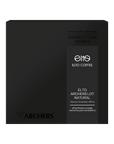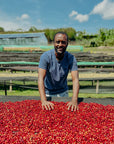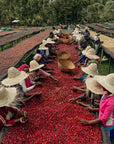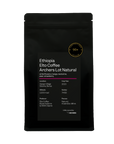‘Ethiopian heirloom’ is the general term commonly used to identify coffee originating from Ethiopia. It covers two classifications: Jimma Agricultural Research Center (JARC) varieties and regional landrace varieties. JARC varieties were developed and released to improve the productivity and livelihood of smallholder coffee farmers, to boost the country's coffee industry.
These varieties are promoted and bred because of their good quality (when grown at the recommended elevations), resistance to or tolerance of adverse elements, and adaptability to diverse environmental conditions. There are 40+ JARC varieties comprised mostly of pure line selections and a handful of hybrids. Regional landraces, meanwhile, are varieties that propagate in the wild, without regulated interventions.
Sidama Bensa-grown 74158, a JARC variety generally observed to express Geisha-esque floral, citrus, and honeyed notes, has consistently ranked among the best at the Ethiopia Cup of Excellence and fetched the highest prices at the auction.
The Archers Lot
Archers Lots culminate our co-founders’ creativity and technical acumen to compose truly artisanal specialty coffee experiences for both the discerning and adventurous specialty coffee connoisseurs, in collaboration with our closest producing partners.
In this Archers-curated 48-hour natural anaerobic process, the perfectly ripe, hand-harvested, and carefully pre-cleaned cherries were re-sorted on raised beds to ensure uniformity of the ripeness level (visually indicated by color) before being placed in 50-60 KG plastic barrels and then sealed with lids having a one-way valve — to aid in maintaining an oxygen-free fermentation phase throughout the pre-determined 48-hour period.
After this, the barrels were emptied onto the raised beds, as the whole cherries were evenly spread out in very thin layers, allowing the fermentation juices to sufficiently drain off of them. The specific instruction to maintain very thinly layered cherries throughout the sun-drying phase was deliberate, to avoid extraneous microbial activity as the coffees had already undergone the necessary fermentation in the barrels prior. The target moisture level was achieved after 18 to 21 days.
As a result of this process, this cup expresses a dainty balance of florals, intense and multi-faceted sweetness with a touch of tropicality, with complex acidities from pome, stone, and tropical fruits and berries, as well as an enhanced, creamy mouthfeel.








